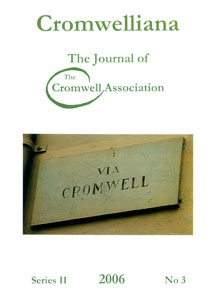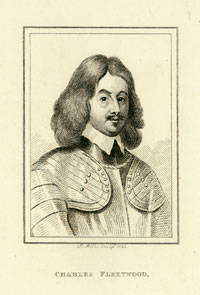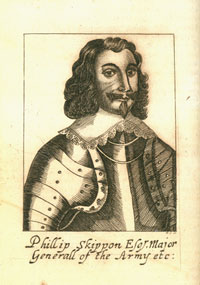
I have in my collection approximately 200 manuscripts relating to the Protectorate period. One of them, obtained from a manuscript dealer as an individual item and not as part of a group, has a particular interest for students of the politics of the period. It is an original election return of the County of Norfolk, for the Protectorate Parliament of 1654. This election return gives the precise number of votes obtained by every candidate, and was obviously written down at the ‘count’ by the Sheriff, who was the seventeenth century equivalent of what is today called ‘the returning officer’. A close study of the document yields many fascinating conclusions about the unpopularity of the Protectorate with the voters, while at the same time indicating that the voters were essentially of Parliamentary or republican sympathies, despite electing one prominent royalist as an obvious act of protest. Humiliation was heaped by the voters upon various leading pillars of the Protectorate who were not Norfolk men, in a manner most embarrassing to the Government.
The reasons why this document is so important are that it gives the names of all the candidates including the defeated ones, and additionally it gives the numbers of votes cast for each candidate. Even Secretary of State John Thurloe, the Protectorate’s spymaster, apparently did not receive or keep such documents. Amongst the Thurloe Papers there is a list reporting the election of Irish Members of the 1654 Parliament, but it only gives the names of those elected, not of those defeated, and no vote totals are recorded. Furthermore, this list states of ‘the Precinct of Londonderry’ (in the Province of Ulster): ‘No return come’, indicating that lists such as his were compiled on the basis of the victorious candidates appearing in the returns, whereas the document under our consideration here is an actual sheriff’s return rather than a list merely summarizing such returns. The summary of returns for Ireland was evidently supplied to Thurloe by Lieutenant-General Charles Fleetwood, who perhaps did not wish to report to London any embarrassing voting figures. This is hardly surprising, as Fleetwood was prominently rejected by the voters of Norfolk, as we shall see below, and calling attention to any figures might raise the question of his own results elsewhere!
In the document transcribed below, the first ten names on the list were selected to sit in the 1654 Protectorate Parliament for the County of Norfolk, and a line is drawn under the vote total for the tenth name on the list, indicating that those below that list were rejected. For purposes of clarification, I should explain that a ‘Knight of the Shire’ was a type of M.P.; in earlier Parliaments, each county (‘shire’) elected two ‘Knights of the Shire’ to sit in Parliament as representatives of the shire at large, whereas the remainder of M.P.s represented borough seats. This system was changed by Cromwell’s regime, so that in the 1654 Parliament there were many more ‘Knights of the Shire’ and fewer borough M.P.s. The distinguished historian Samuel Gardiner explained the process and the intention behind it very well, and I can do no better than to quote his account:
‘So far as the elections were concerned the framers of the Instrument [i.e., The Instrument of Government, sworn to by Oliver Cromwell in Westminster Hall on December 16, 1653, by which his Protectorate Government was established] had done their best to secure a favourable verdict. Resting, as they did, their hopes on the middle class, they had dealt roughly with the small boroughs, which fell naturally under the influence of the neighbouring gentry. Whereas the Long Parliament [elected in 1640] had contained 398 borough members, there were but 133 in the Parliament of 1654. The University representation [i.e., the Members for Cambridge and Oxford] sank at the same time from 4 to 2, whilst the number of county members [i.e., ‘Knights of the Shire’] was raised from 90 to 265. If the small boroughs were to be disenfranchised, it was impossible to divide the representation in any other way. … Partly, perhaps, with a view to the avoidance of opposition, but still more, it may safely be conjectured, in order to favour the middle class, the right of voting, so far as the boroughs were concerned, was left untouched. … In the counties more drastic measures had been taken. The time-honoured forty-shilling freeholder disappeared from political life, giving way to a new class of voters possessed of personal or real property valued at 200 pounds – equivalent to at least 800 pounds at the present day [1903].’
Hence it was that in this Parliament, the County of Norfolk ceased to be represented by only two county M.P.s, and instead came to be represented by ten. The text of the document follows:
Official Election Return for the County of Norfolk:
1654 [July]
By the Lord Protector Cromwells Writ Ten Persons were chosen out of the following Number that stood to be Knights of the Shire.
| Sir Wm Doyley Sir John Hobart Sir Ralph Hare Robert Wilton Thomas Sotherton Robert Wood Philip Wodehouse Philip Bedingfield Thomas Weld Tobias Frere Ld Fleetwood Deputy Ireland Brampton Gurdon Colonel Rob. Jeremy Major Haynes Henry King Sr John Palgrave Mr Buller of Geyst Philip Skippon Charles Geo. Cock |
2501 2152 1539 1555 1513 1369 1439 1378 1753 1167 ____ 1054 857 647 501 601 549 578 586 1040 |

It is interesting that in the above list, a major stalwart of the Protectorate, Lieutenant General Charles Fleetwood, who had been appointed by Cromwell as Lord Deputy [equivalent to Viceroy] of Ireland, and who was Cromwell’s own son-in-law (he was second husband of Cromwell’s oldest daughter, Bridget), was unable to attract sufficient support from the voters to make it into the top ten. The following year, in 1655, Fleetwood would be appointed as ‘Major General’ (i.e. military governor) for the Eastern District of England, and Norfolk was part of this district, hence would come directly under his official command. His rejection by the voters there only a year earlier would have been a serious embarrassment, as he could only manage to come eleventh in a county which he was shortly to rule.
Also unable to obtain sufficient voter support was Major General Philip Skippon, an older man who had served with considerable distinction as one of the more successful generals on the Parliament side during the Civil War. The fact that these two pillars of Cromwell’s government were rejected by the voters indicates serious lack of public support for the military government of the Protectorate. However, Fleetwood was elected three times over anyway, as Knight of the Shire for Oxfordshire, as M.P. for the Wiltshire borough seat of Marlborough, and simultaneously for the Oxfordshire borough seat of Woodstock). Cromwell was obviously taking no chances, and put him up as a simultaneous candidate in four different places (though his standing for the County of Norfolk has apparently not previously been known or recorded), so he got into the Parliament despite his rejection by the voters of Norfolk.
Philip Skippon was also nevertheless elected for Norfolk in a roundabout way, having stood also to be a borough M.P. at Kings Lynn, called then Lyn Regis (and mis-named ‘Lyme’ in the Dictionary of National Biography entry for Skippon), one of only three borough seats permitted to hold elections in that county in 1654. In this borough seat, where it was easier to exert influence over the election result, Skippon was returned, despite being rejected by the voters of the county at large. In the list as recorded by Browne Willis from official documents in London, Skippon is further described as ‘one of his Highness’s Council’. ‘His Highness’ is of course Oliver Cromwell at this period. The ‘Council’ is the governing body, the Council of State. Skippon was named a peer by Cromwell in 1657 and died in 1660.

Two men elected as Knights of the Shire in the above list are further distinguished in Browne Willis’s list (Ibid., pp. 263-4) as being ‘Senior’, i.e. to distinguish them from their sons of the same name: these were Robert Wood and Philip Bedingfield.
In the succeeding Protectorate Parliament of 1656, where tighter control was exercised over the election process, Charles Fleetwood heads the list of elected Knights of the Shire for Norfolk, so Cromwell’s regime was successful at getting him in on the second attempt, presumably by intimidation. (Fleetwood was also simultaneously elected as the leading Knight of the Shire for Oxfordshire, just to be on the safe side.) In Willis’s list for 1656, both Hobart and Hare are described as baronets. In 1656, Charles George Cock, who had been unsuccessful as a knight of the shire in 1654, managed to get in at Great Yarmouth. In 1656, the following 1654 knights of the shire did not manage to get elected: Philip Bedingfield, Thomas Weld, and Tobias Frere. Their places were taken by Fleetwood, John Buxton, and Sir Horatio Townshend, Bart. Of these, Sir Horatio Townshend (born circa 1630, died 1687) became a member of the Council of State in 1659, was active in the restoration of Charles II in 1660, and was ennobled by Charles II as First Baron Townshend in 1661, and raised higher as Viscount Townshend in 1682.
As can be seen, eight of the nineteen men who stood for election as Knights of the Shire for Norfolk had for years been members of the Norfolk Committee, the committee established by Parliament at the commencement of the Civil war to run the county. It was natural for them to attempt to continue their control of the county and to wish to represent Norfolk in Parliament, as they had been running its affairs for years. Many of them were not of true gentry status, but were of what was then called ‘the middling sort’, which is why so little information is available concerning them and their family backgrounds. Three others of the nineteen men, as has been seen, were clearly attempts by the Cromwell regime to impose its own men on the county, and at the county level, all three were soundly rejected. This fact, together with the triumph of an overt royalist, Sir William Doyley, indicates the level of opposition to the Protectorate in Norfolk in 1654. However, of the ten men elected as knights of the shire, no less than seven had been Parliament’s commissioners on the Norfolk Committee. The fact that they were still so popular after years of rule indicates more than familiarity with local personalities, it appears to show that Norfolk was not hostile to the Parliamentary cause, but merely to the Protectorate.
